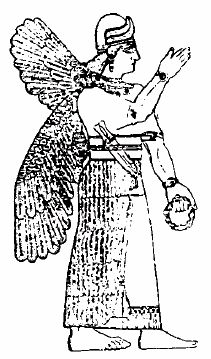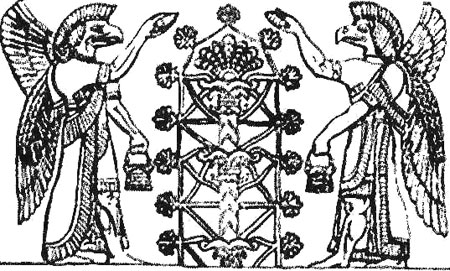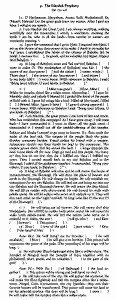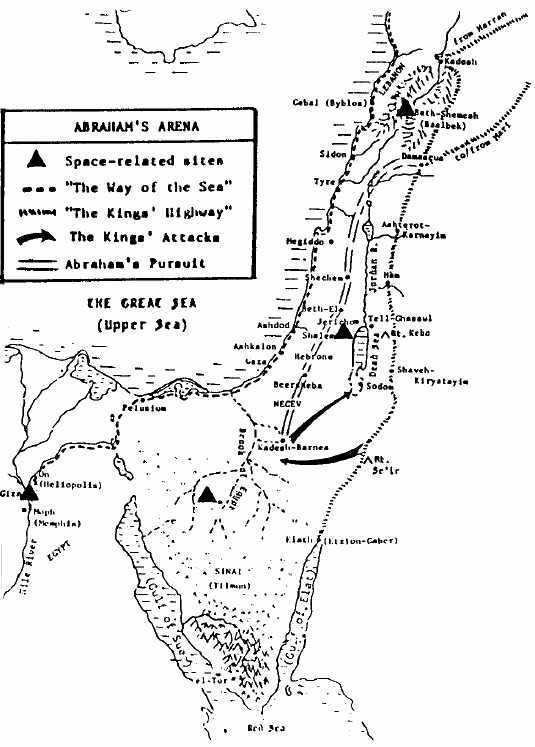|
COUNTDOWN TO DOOMSDAY
Unable to claim the status of a demigod, he asserted (in his inscriptions) that he was nevertheless born under divine auspices:
That was a genealogical claim not to be sneezed at. Ur-Nammu himself, as earlier stated, was “two-thirds” divine, since his mother was a goddess. Though the High Priestess who was Shulgi’s mother is not named, her very status suggests that she, too, was of some godly lineage, for it was a king’s daughter who was chosen to be an EN.TU; and the kings of Ur, starting with the first dynasty, could be traced back to demigods.
That Nannar himself arranged for
the union to take place in Enlil’s temple in Nippur was also
significant; as previously stated, it was under Ur-Nammu’s reign
that for the first time the priesthood of Nippur was combined with
the priesthood of another city—in this case, with the one in Ur.
Deeming himself a successor to Gilgamesh, his route embraced the two destinations of that famed hero: the Sinai peninsula (where the spaceport was) in the south and the Landing Place in the north.
Observing the sanctity of the Fourth Region, Shulgi skirted the peninsula and paid homage to the gods at its boundary, at a place described as “Great fortified place of the gods.” Moving northward west of the Dead Sea, he paused to worship at the “Place of Bright Oracles”—the place we know as Jerusalem—and built there an altar to “the god who judges” (usually an epithet of Utu/Shamash).
At the “Snow-covered Place” in the north, he built an
altar and offered sacrifices. Having thus “touched base” with the
reachable space-related sites, he followed the “Fertile
Crescent”—the arching trade and migration east–west route dictated
by geography and water sources—then continued southward in the
Tigris-Euphrates plain, back to southern Sumer.
Shulgi in his inscriptions boasted of
victory, but in fact, soon thereafter, he started to build a
fortified wall to protect Sumer against foreign incursions from the
west and from the northwest.
We don’t know what kind of death it was, but it is a
historic fact that in that year he was replaced on the throne of Ur
by his son Amar-Sin, of whom we know from the inscriptions that he
launched one military expedition after another—to quell a revolt in
the north, to fight an alliance of five kings in the west.
That the “Lands of the West” along the Mediterranean coast were
somehow disputed territory was also indicated by ancient Egyptian
texts regarding the bitter contest between Horus and Seth that ended
in aerial battles between them over the Sinai and the same contested
lands.
The prize there was a place called TIL.MUN—the
“Place of the Missiles”— the site of the post-Diluvial spaceport of
the Anunnaki. When the Pyramid Wars ended, the sacred Fourth Region
was entrusted to the neutral hands of Ninmah (who was then renamed
NIN.HAR.SAG—“Lady of the Mountain Peaks”), but actual command of the
spaceport was put in the hands of Utu/Shamash (here shown in his
winged dress uniform, Fig. 29, commanding the spaceport’s
“Eaglemen,” Fig. 30).
Enki was apparently involved in that, for a text dealing with the affair between Enki and Ninharsag states that the two of them decided to allocate the place to Marduk’s son:
The ancient sources indicate that from the safety of the sacred region Nabu ventured to the lands and cities along the Mediterranean coast, even to some Mediterranean islands, spreading everywhere the message of Marduk’s coming supremacy.
Figure 29
He was, thus, the enigmatic “Son-Man” of the Egyptian and
the Akkadian prophecies—the Divine Son who was also a Son-Man, the
son of a god and of an Earthling woman.
Starting in 2047 b.c.e., the sacred Fourth Region became a target
and a pawn in the Enlilite struggle with Marduk and Nabu; and as
both biblical and Mesopotamian texts reveal, the conflict erupted to
the greatest international "world war" of antiquity. Involving the
Hebrew Abraham, that “War of the Kings” placed him in center stage
of international events.
The famed “Merchants of Ur” came there for
Harran’s wool, and brought in exchange to distribute from there Ur’s
famed woolen garments. Commerce in metals, skins, leather, woods,
earthenware products, and spices followed. (The Prophet Ezekiel, who
was exiled from Jerusalem to the Khabur area in Babylonian times,
mentioned Harran’s “merchants in choice fabrics, embroidered cloaks
of blue, and many-colored carpets.”)
We know about Terah, his family, and their move from Ur to Harran from the Bible:
It is with these verses that the Hebrew Bible begins the pivotal tale of Abraham—called at the beginning by his Sumerian name Abram.
His father, we are told earlier, stemmed from a patriarchal line that went all the way back to Shem, the oldest son of Noah (the hero of the Deluge); all those Patriarchs enjoyed long lives—Shem to the age of 600, his son Arpakhshad to 438; and subsequent male offspring to 433, 460, 239, and 230 years.
Nahor, the father of Terah, lived
to age 148; and Terah himself—who fathered Abram when he was seventy
years old—lived to age 205. Chapter 11 of Genesis explains that
Arpakhshad and his descendants lived in the lands later known as
Sumer and Elam and their surroundings. So Abraham, as Abram, was a
true Sumerian.
The name of Abram’s wife, SARAI (later Sarah in Hebrew), meant “Princess”; the name of Nahor’s wife, Milkhah, meant “Queenlike”; both suggest a royal genealogy. Since it was later revealed that Abraham’s wife was his half-sister—“the daughter of my father but not of my mother,” he explained—it follows that Sarai/Sarah’s mother was of royal descent.
The family thus belonged to Sumer’s highest echelons, combining
royal and priestly ancestries.
But I
believe that the term was more specific. The name used for Sumer’s
"Vatican City," Nippur, is the Akkadian rendering of the original
Sumerian name NI.IBRU, “Splendid Place of Crossing.”
Soon thereafter, the
priesthoods of Nippur and Ur were combined for the first time; it is
very likely that it was then that the Nippurian priest Tirhu moved
with his family, including the ten-year-old boy Abram, to serve in
Nannar’s temple in Ur.
It was in 2048 b.c.e. that the two moves occurred:
We know from Genesis that Abram was seventy-five years old, and it was thus 2048 b.c.e., that he was told by God,
As to Marduk, a long text known as the Marduk Prophecy that he addressed to the people of Harran (clay tablet, Fig. 31) provides the clue confirming the fact and the time of his move to Harran: 2048 b.c.e. There is no way the two moves could have been unrelated.
Figure 31
But 2048 b.c.e. was also the very year in which the Enlilite gods
decided to get rid of Shulgi, ordering for him the “death of a
sinner”—a move that signaled the end of “let’s try peaceful means”
and a return to aggressive conflict; and there is no way that this,
too, was just a coincidence.
No, the three moves,
...had to be interconnected: three
simultaneous and interrelated moves in the Divine Chessgame.
Augmented by the Date Formulas and varied other references, the principal sources for reconstructing those dramatic events are the relevant chapters in:
As in a movie—usually
a crime thriller—in which the various eyewitnesses and principals
describe the same event not exactly the same way, but from which the
real story emerges, so are we able to reach the same result in this
case. Marduk’s main chess move, in 2048 b.c.e., was to establish his command post in Harran. By that he took away from Nannar/Sin this vital northern crossroads and severed Sumer from the northern lands of the Hittites. Besides the military significance, the move deprived Sumer of its economically vital commercial ties.
The move also enabled Nabu “to marshal his cities, toward the Great Sea to set his course.”
Place names in these texts suggest that the
principal cities west of the Euphrates River were coming under full
or partial control of the father–son team, including the
all-important Landing Place.
The Bible is mum
regarding the reason for this royal treatment, except to hint that
the Pharaoh, being told that Sarai was Abram’s sister, assumed that
she was being offered to him in marriage—a step that suggests that a
treaty was discussed. That such high level international
negotiations were taking place between Abram and the Egyptian king
seems plausible when one realizes that the year when Abram returned
to the Negev after a seven-year stay in Egypt—2040 b.c.e.—was the
very same year in which the Theban princes of Upper Egypt defeated
the previous Lower Egypt dynasty, launching Egypt’s unified Middle
Kingdom.
As the biblical narrative reveals, he now had with him an elite force of Ne’arim—a term usually translated “Young Men”—but Mesopotamian texts used the parallel term LU.NAR (“NARmen”) to denote armed cavalrymen. It is my suggestion that Abraham, having learnt in Harran tactics from the militarily excelling Hittites, obtained in Egypt a striking force of swift camel-riding cavalrymen.
His base in Canaan was again the Negev, the
area bordering the Sinai Peninsula.
The group of tablets named the Khedorla’omer Texts was first brought to scholarly attention by the Assyriologist Theophilus Pinches in a lecture at the Victoria Institute, London, in 1897.
They clearly describe the same events that are the great international war of Chapter 14 of Genesis, though in much greater detail; it is quite possible, indeed, that those tablets served as the source for the biblical writers. Those tablets identify “Khedorla’omer king of Elam” as the Elamite king Kudur-Laghamar, who is known from historical records.
“Ariokh” has been identified as ERI.AKU
(“Servant of the Moon god”), who reigned in the city of Larsa
(biblical “Ellasar”); and Tidhal was identified as Tud-Ghula, a
vassal of the king of Elam.
The Wars
of Gods and Men that the Hebrew should be read not Amra-Phel but
Amar-Phel, from the Sumerian AMAR.PAL—a variant of AMAR.SIN— whose
Date Formulas attest that he did indeed, in 2041 b.c.e., launch the
War of the Kings.
But sight was not lost of the prime target: the spaceport. The invading forces followed what has been known since biblical times as the Way of the King, running north–south on the eastern side of the Jordan.
But when they turned westward toward the gateway to the Sinai Peninsula, they met a blocking force: Abraham and his cavalrymen (Fig. 32).
Figure 32
Referring to the Peninsula’s gateway city Dur-Mah-Ilani (“The gods’ great fortified place”)—the Bible called it Kadesh-Barnea—the Khedorla’omer Texts clearly stated that the way was blocked there:
“The son of the priest,” anointed by the gods, I suggest, was
Abram
the son of the priest Terah. The Dead Sea was then shorter; its current southern appendix was not yet submerged, and it was then a fertile plain rich with farmland, orchards, and trading centers.
The settlements there included five cities, among them the infamous Sodom and Gomorrah.
Figure 33 Turning northward, the invaders now faced the combined forces of what the Bible called “five sinning cities.”
It was there, the Bible reports, that the four kings fought and defeated the five kings. Looting the cities and taking captives with them, the invaders marched back, this time on the western side of the Jordan. The biblical focus on those battles might have ended with that turning back were it not for the fact that Abram’s nephew Lot, who resided in Sodom, was among the captives.
When a refugee from Sodom told Abram what had happened,
His cavalry caught up with the invaders all the way north, near Damascus (see Fig. 32), where Lot was freed and the booty recovered.
The Bible records the feat as the,
The historical records suggest that as audacious and far-flung that War of the Kings had been, it failed to suppress the Marduk-Nabu surge. Amar-Sin, we know, died in 2039 b.c.e.—felled not by an enemy lance, but by a scorpion’s bite. He was replaced in 2038 b.c.e. by his brother Shu-Sin.
The data for his nine years’ reign record two
military forays northward but none westward; they speak mostly of
his defensive measures. He relied mainly on building new sections of
the Wall of the West against attacking Amorites. The defenses,
however, were moved each time ever closer to Sumer’s heartland, and
the territory controlled from Ur kept shrinking.
Directing and prompting the Westerners on toward the cherished target was Nabu. His divine father, Marduk himself, was waiting in Harran for the recapture of Babylon.
|






